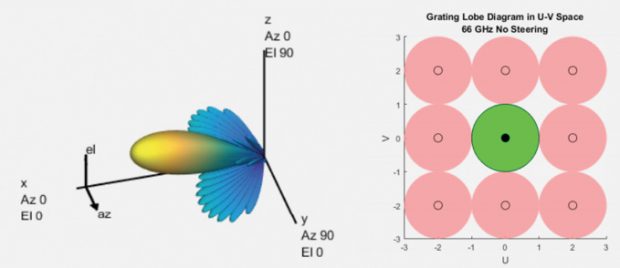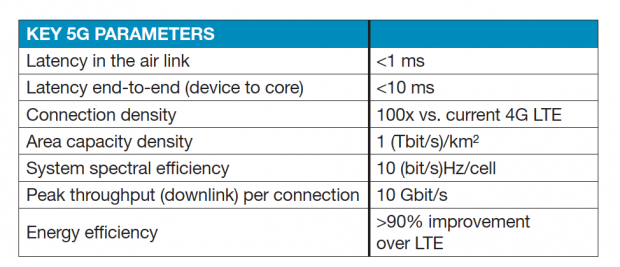5G-Based Product Development
Latest News
June 1, 2018
The term “5G” may not exactly be a household name yet, but those working on the next-generation wireless cellular network standard say it won’t be long before its massive upgrade in bandwidth and throughput technology will radically change how we use wireless cellular networking for both consumer and industrial applications. By using millimeter-wave bands and MIMO (multiple-input multiple-output) antenna arrays, 5G will provide speeds up to 20 gigabits per second—that’s up to 10 times faster than the current wireless cellular standard 4G.
The speed and data throughput 5G offers is being touted as a solution for many technologies that promise much but are hamstrung by data throughput and latency issues. Virtual reality (VR) will be able to work without a wired connection, and motion sickness caused by its latency should be eliminated. Researchers in autonomous vehicles say the ultra-low (1 ms) latency of 5G offers the possibility of cars communicating with each other in traffic, synchronizing their movements through city streets or highways as smoothly as a hive of bees or synchronized flock of birds.
 A beam pattern and grating lobe diagram for 66 GHz 64x64 element design, designed with MathWorks Antenna Toolbox. Image courtesy of MathWorks.
A beam pattern and grating lobe diagram for 66 GHz 64x64 element design, designed with MathWorks Antenna Toolbox. Image courtesy of MathWorks.One distinctive aspect of 5G ,when compared to preceding wireless standards, is not obvious at first: 5G is the first standard to be optimized for computers, not for humans. Voice calls are rarely mentioned in any technical discussion of 5G features and capabilities.
All of this hype and promise means big engineering challenges, not just for those deploying the actual hardware required to distribute 5G, but all the billions of new devices that will take advantage of the 5G tsunami. The industrial internet of things (IIoT) will be a prime beneficiary of 5G, enabling many new applications and integration of existing products.
Thought leaders are already describing scenarios of how 5G will improve existing processes and augment current infrastructure, then go on to empower new services like teleoperation of machines and other situations that rely on interface and control of real objects using digital technology. Writing new business models might not be on the R&D agenda, but the possibilities available with 5G adoption will force many companies to rethink their businesses—and provide opportunities for smart startups.
Edge or Fog?
New research into localized computing and connectivity for industrial environments—known as edge or fog computing—will extend current notions of cloud computing by allowing direct machine-to-machine computation and storage, with 5G connectivity replacing existing Wi-Fi or 4G connections. Network hardware vendor Cisco forecasts 50 billion connected devices by 2020 “chattering to one another in the background over 5G, dealing with small, low-data applications.”Ginny Nichols, from Cisco, coined the term “fog computing” in 2014 to describe the extension of cloud computing to the edge of an enterprise’s network. Although “fog” and “edge” are often used interchangeably in describing newly distributed and decentralized computing IIoT environments, there are differences. In a fog environment, intelligence is at the level of the local area network. Data moves from endpoints to a gateway, and from there to processing sources. In an edge environment, processing is more decentralized as the devices are capable of higher-level computation and direct machine-to-machine data use.
The IIoT will use either fog or edge computing—most likely both—to deliver integration between operational technology and information technology. The goal is to deploy IT-enabled (smart) machines, networked sensors and data analytic systems that serve the device, its owner and the vendor. If the IIoT were an organism, 5G would be its nervous system.
Model-Based Engineering for 5G Deployment
Product engineering teams will need software tools that provide test bed utility as well as reference architecture for adding 5G capabilities to smart products. One engineering software company tackling the move to 5G is MathWorks, working closely with standards agency 5GPP. MathWorks is already providing software tools for engineers who need to create 5G compatible products, with an emphasis on making 5G accessible to engineers who have no prior background.“5G is proving to be revolutionary,” says Arun Mulpur, industry marketing manager for Communications, Semiconductors and Networks at MathWorks. “The when and how of coming to market” is how MathWorks sees its role in preparing product engineers for working in 5G. “Our experience shows you don’t find 5G experts in [product] engineering organizations,” he adds. So, MathWorks is adding tools and knowledge specific to 5G development into the products engineers already know.
Manufacturers like Ericsson have documented how the use of test beds accelerated time-to-market in developing 4G and LTE products. MathWorks is bringing the notion of software models as virtual testbeds to 5G development. In particular, they are extending the use of model-based design for development and testing of 5G algorithms and related system architectures. Because of this approach, MathWorks products MATLAB and Simulink can be used to iterate and simulate new design concepts. When the algorithm runs correctly in simulation, engineers can then generate synthesizable Verilog or VHDL (VHSIC hardware description language) code for deployment to a field-programmable gate array-based hardware testbed.
Mulpur says model-based design for 5G-compatible products is like the digital thread notion used in aeronautics. “There is the notion of Golden Reference, one truth in one model,” he says. “Changes are propagated from the model.”
While 5G standards are not finalized, there is a standard draft to work from. Mulpur recommends R&D teams act now, in advance of 5G standards finalization. “It is not a good idea to wait for full ratification. Tool vendors will provide what is needed to do the work now, allowing manufacturers to be ready to deploy when 5G comes online,” he says.
Big companies like Ericsson may be the known leaders in the field, but Mulpur says small companies should not feel left out in the cold. Products like MATLAB and Simulink give startups “a common toolset conducive to doing executable specifications, with standards-compliant models and libraries. These are the building blocks for small teams to build a compliant system model in a test bench,” Mulpur says.
Cyberphysical Manufacturing System Demands
University researchers from National Chung Hsing University and Beihang University (goo.gl/HCuFLh) note that current wireless network standards cannot meet the contemporary demands of cyberphysical manufacturing systems (CPMS), which generate “massive amounts of data.” 5G, they say, has the “significant potential to promote IIoT and CPMS.” The research team has proposed the development of 5G-based IIoT devices for three “typical application modes” of enhanced mobile broadband, massive machine type communication and ultra-reliable and low-latency communications (URLLC).Among the many industrial benefits, the researchers foresee the widespread use of augmented reality and VR, due to the increased throughput of data and low latency 5G offers. “It will improve production efficiency, reduce production cost and enhance product quality though applying virtual reality and augmented reality in product design, manufacturing, maintenance and production equipment overhaul,” they state. They cite the existing example of oil and gas vendor Total using Siemens VR software to train staff for offshore installation work.
The abstract is quite enthusiastic about the long term. “IIoT aims to realize ambient ubiquity networks in industrial environments based on the technologies of reliable sensing, computer networks, real-time communications, and big data,” the researchers write. “IIoT can acquire the important manufacturing process parameters with lower cost, more convenience and higher applicability, which cannot be acquired in the traditional industrial production line.”
More Info
5GPPPSubscribe to our FREE magazine, FREE email newsletters or both!
Latest News
About the Author
Randall S. Newton is principal analyst at Consilia Vektor, covering engineering technology. He has been part of the computer graphics industry in a variety of roles since 1985.
Follow DE






 Key elements of 5G technology. Table courtesy of MathWorks.
Key elements of 5G technology. Table courtesy of MathWorks.